


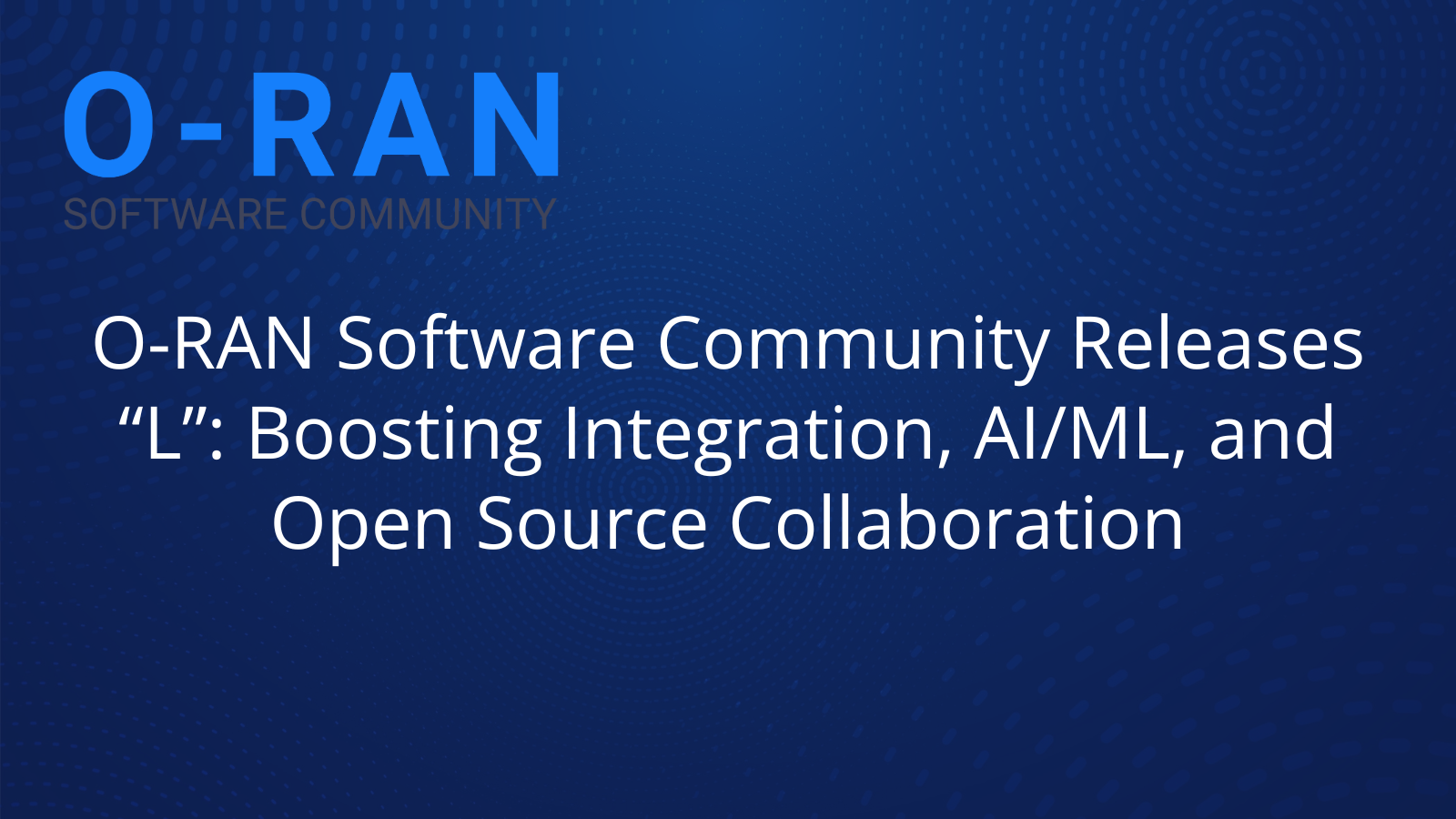
The O-RAN Software Community (O-RAN SC) is excited to announce the L Release, the latest update in our collaborative mission to deliver open, intelligent, and interoperable RAN software. Reflecting current and evolving alignment with O-RAN ALLIANCE specifications and developed through contributions from across the global open source ecosystem, this release introduces improvements in integration, automation, and AI/ML enablement across the stack.
Whether you’re a developer, network operator, academic researcher, or open source advocate, the L Release provides powerful building blocks to support testing, integration, and innovation across the Open RAN (O-RAN) ecosystem.
The L Release is a major milestone for the open RAN and open source communities. It highlights how cross-industry collaboration and transparent development practices can drive the evolution of modular, intelligent, and interoperable RAN technologies.
Key benefits of the L Release:
The L Release delivers updates across four key areas:
Whether you’re building next-generation mobile networks, developing new xApps or rApps, or researching AI in telecom, the O-RAN Software Community welcomes your involvement.
Stay tuned for what’s next in the M Release!

The Open Source Focus Group (OSFG) of the O-RAN ALLIANCE convened an ad-hoc meeting on May 23, 2025, hosted by Ericsson in Kista, Sweden. The goal: to identify key open source initiatives relevant to O-RAN, evaluate testing infrastructure needs, and begin planning a collaborative workshop for later this year. The event brought together participants from the O-RAN Software Community (SC), O-RAN Working and Focus Groups, and multiple member companies across the ecosystem.
The meeting began with a restatement of OSFG’s mission, led by Co-Chairs Irfan Ghauri (EURECOM/OpenAirInterface), James Li (China Mobile), and David Kinsey (AT&T), supported by Martin Skorupski (Highstreet Technologies). The group reaffirmed its commitment to openness, transparency, and non-confidential discussion per O-RAN ALLIANCE guidelines.
A series of technical presentations offered insight into open source workstreams intersecting with O-RAN priorities:
OSFG is actively working to align with other Linux Foundation and CNCF projects. Efforts include outreach and coordination with:
The group discussed possibly inviting representatives from these projects to the next OSFG workshop.
A brief update on the EU Cyber Resilience Act (CRA) was delivered by Jimmy Ahlberg (Ericsson). Key takeaways:
Sridhar Rao (Linux Foundation) led a discussion on O-RAN SC’s CVE process—covering scanning, dashboard reporting, and plans to bring on interns to address critical issues by the end of 2025. The group is also exploring whether CVE data should be published on [cve.org] and/or in blog posts.
A proposal was made to request funding for security interns via TOC (Technical Oversight Committee). The broader question of each project’s security stance (“want to fix,” “not interested,” etc.) remains open and will be addressed at the project level in O-RAN SC meetings.
The OSFG officially acknowledged the signed Memorandum of Understanding (MoU) between O-RAN ALLIANCE and the Linux Foundation Networking (LFN), which establishes a basis for inviting LFN participants into OSFG activities. The meeting explored ways to streamline the invitation process for recurring contributors.
The group concluded with action items to support an upcoming workshop tentatively targeted for September 2025. Nephio is already planning a face-to-face event, and a joint session with OSFG/O-RAN SC was proposed. The group aims to:
The OSFG ad-hoc meeting in Kista underscored the importance of open collaboration, strategic alignment, and technical integration between the O-RAN ecosystem and open source communities. With a renewed focus on testing infrastructure, security posture, and a shared workshop agenda, the group is poised to enhance the impact of open RAN across global deployments.For additional details or to get involved, please visit the O-RAN SC website.
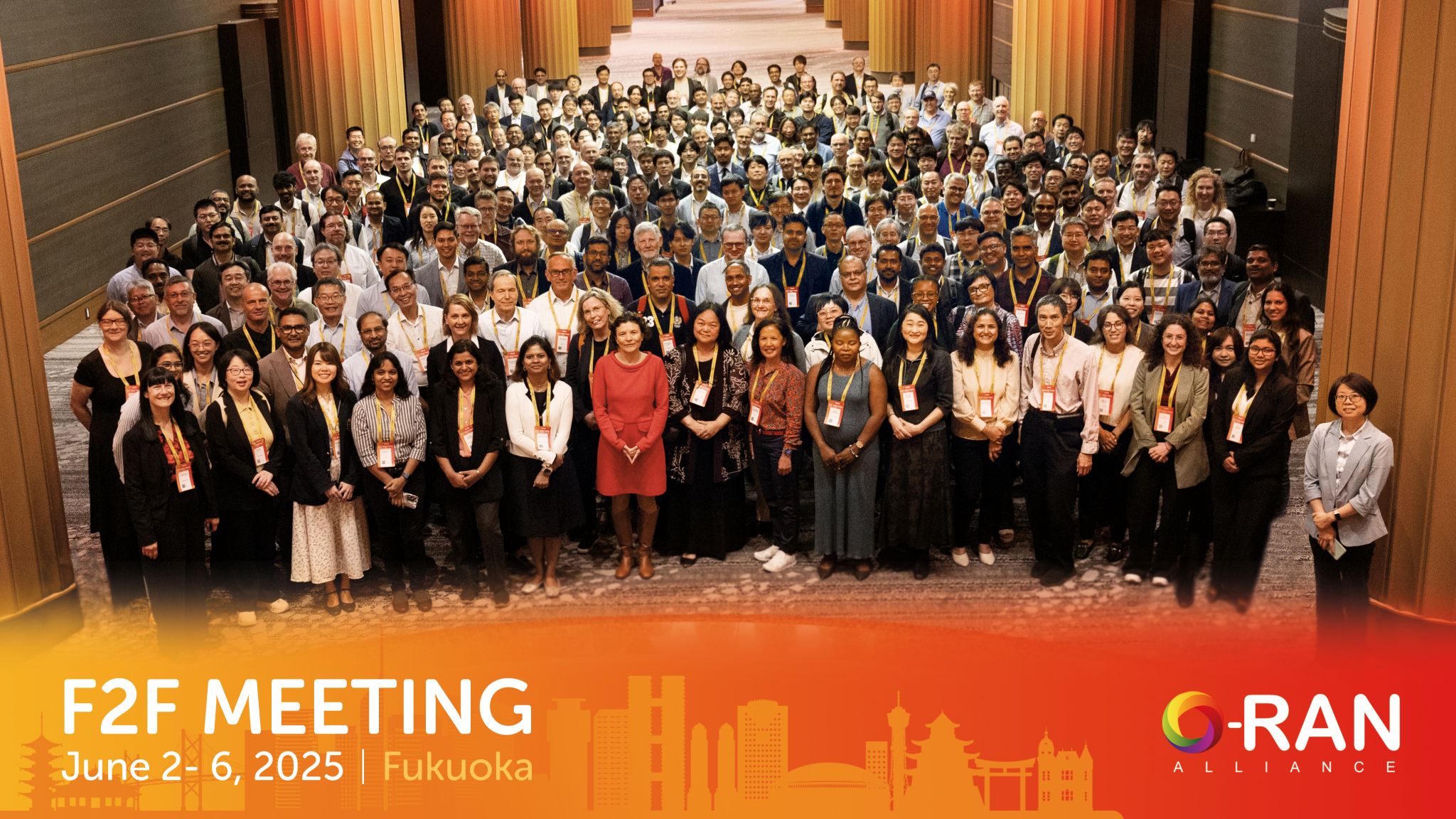
The O-RAN Software Community (SC) is proud to participate in the O-RAN ALLIANCE Face-to-Face (F2F) Meeting this week in Fukuoka, Japan—a vital gathering that brings together stakeholders from across the global Radio Access Network (RAN) ecosystem. This event is a cornerstone of collaboration, offering a unique opportunity for in-person discussions, planning, and alignment between industry experts from around the world.
With 320 experts from 94 companies and institutions joining in person—and many more connecting remotely—this meeting is a vibrant hub of innovation and progress. Participants span a wide range of sectors, including mobile network operators (MNOs), vendors, research institutions, academia, and government agencies, all working toward the common goal of defining and advancing open, intelligent, and disaggregated RAN.
Throughout the week, 11 parallel work streams run from morning to evening, filled with Work Group and Focus Group sessions. These intensive meetings allow the community to align on architecture, specifications, implementation plans, and interoperability—all essential for advancing the O-RAN vision. Despite time zones or travel fatigue, the energy is high, and the focus is clear: building the future of RAN together.
Face-to-face collaboration plays a critical role in accelerating standardization and resolving complex challenges. That’s why the O-RAN ALLIANCE organizes F2F meetings three times per year, rotating between Asia, Europe, and the Americas. These gatherings help deepen community bonds and strengthen cross-organizational efforts.
The O-RAN Software Community is grateful for the continued dedication of all its members and participants who contribute their time, expertise, and vision. Thank you for helping move the needle toward an open and interoperable RAN ecosystem.
Stay tuned for more updates from Fukuoka and follow our journey at o-ran-sc.org and on LinkedIn.
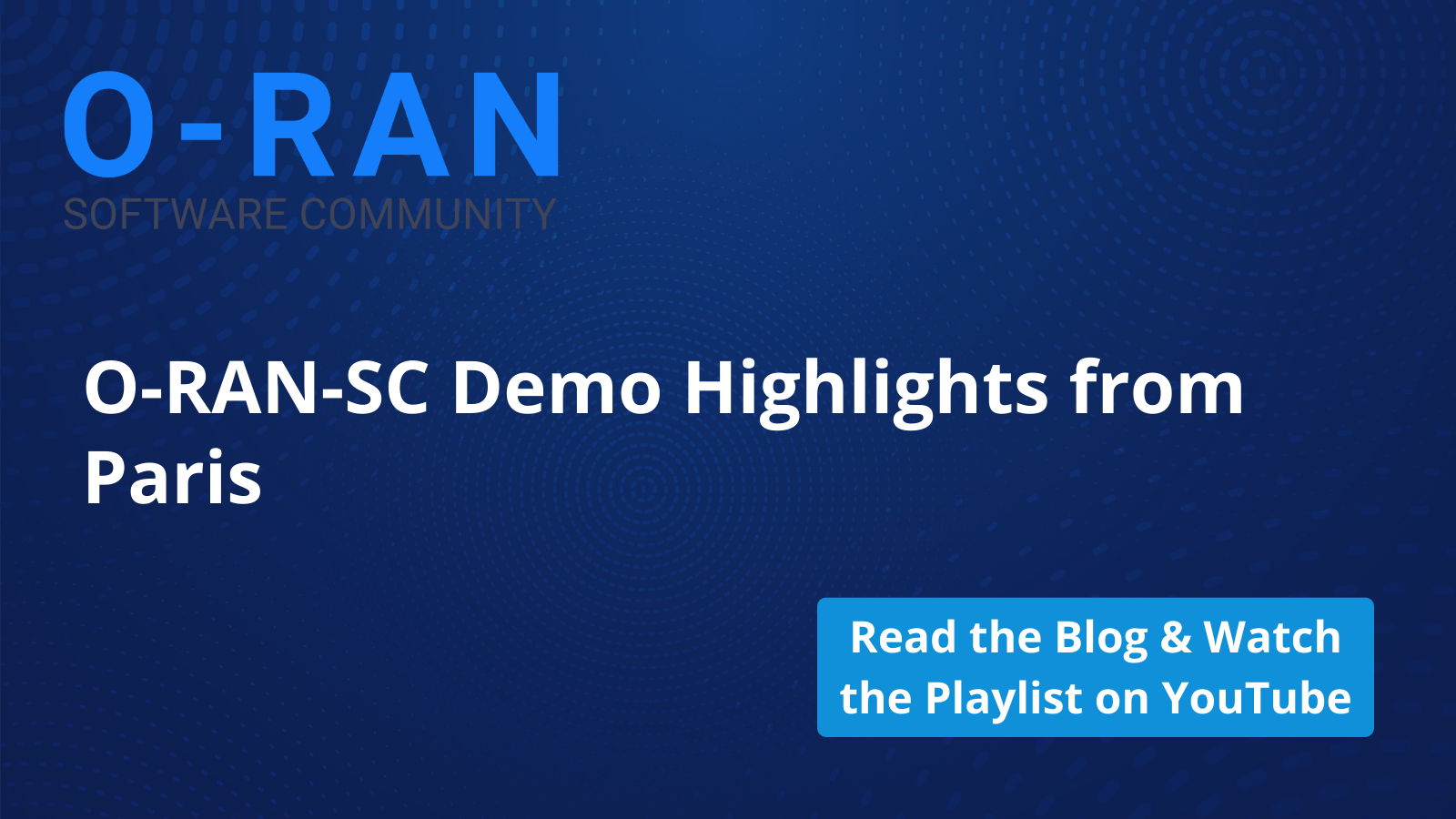
The O-RAN ALLIANCE Face-to-Face Meeting, the first of 2025, took place in Paris. Members of OpenAirInterface Software Alliance (OAI), Nephio, and the O-RAN Software Community (O-RAN-SC), showcased new developments and demos around Service Management and Orchestration (SMO), the Non-RT RIC, Open Fronthaul, and more. Below is a quick walkthrough of the demos, the technology behind them, and why they matter.
Robert Schmidt from the OpenAirInterface (OAI) Software Alliance kicked off by showing a high-throughput, disaggregated 5G OAI gNB setup that uses:
Watch the Video.
Ivan described the new O-RAN-SC Lab co-located with the existing ORBIT and COSMOS testbeds at Rutgers. This environment provides remotely accessible servers, RUs, test equipment, and more for O-RAN-SC developers to run large-scale tests.
Sagar showcased how the Nephio project (under Linux Foundation Networking) can create and manage Kubernetes clusters for O-RAN-SC deployments. By taking an “intent-based” GitOps model, Nephio orchestrates O-Cloud resources and O-RAN workloads.
Watch the Video.
Teodora closed out the session with a look at OAI’s support for O1 management (via NETCONF) and E2 (via FlexRIC, a nearRT-RIC + xApp framework). The goal: demonstrate real-time reconfiguration and performance reporting from a COTS UE, plus monitoring via E2-based xApps.
Watch the Video.
Alex kicked off the demo session with a deep dive into how an O-RU can automatically discover its management-plane (M-Plane) endpoint using DHCP. According to the latest Open Fronthaul M-Plane specs (Release 16.0.1), DHCP can carry far more information than just an IP address—particularly, details about the SMO’s domain name and whether NetConf call-home should happen via SSH or TLS.
In real-world deployments, radios need a fast, standardized way to locate their controlling SMO (or OAM system). By embedding these parameters within DHCP, operators can streamline the “power-on” or “plug-and-play” workflow for large numbers of O-RUs. This demo clarifies how the RU can use DHCP Option 43 to retrieve not just its IP address, but also SMO’s FQDN, NetConf transport type, and even references to event-collector endpoints.
Next up, John Keeney and Jeff demonstrated how SMO can provide a high-level, consolidated view of all the network domains—like RAN, Cloud, OAM systems, and more—via the newly developed Topology Exposure & Inventory Service (TE&IV). They illustrated geographic queries, grouping of network entities (e.g., by location or by type), and dynamic group updates.
Most operators have many data sources—RAN inventory, physical sites, cloud infrastructure details, and so on. O-RAN Alliance Work Group 10 is defining an API so external applications (rApps, for example) can access an abstracted, cross-domain network view rather than piecing everything together themselves. This means your advanced analytics or optimization modules can fetch “just enough” topology info in a single call.
Watch the Video.
Shashikanth gave a broader look at how the O-RAN-SC SMO project is evolving. Specifically, he presented the architecture where federated O-Cloud orchestration (FOCOM) works in tandem with a Network Function Orchestrator (NFO), with supporting modules like an Inventory Management Service (IMS) and a Deployment Management Service (DMS).
Operators often need to unify orchestration across multiple clouds (public, private, or on-prem). The SMO project is exploring new ways to fold in open-source orchestration tools (e.g., StarlingX, Tacker, Open MSA) and handle both VMs and container-based VNFs/CNFs.
Shridhar showcased how the IOS-MCN project in India (backed by the Government of India) is integrating key O-RAN-SC components—especially the OAM, Non-RT RIC, and RAN-PM modules—into their real-world lab. Their setup pairs O-RAN-SC containers with OpenAirInterface (OAI) gNBs and real mobile phones.
It’s a testament to how these open-source modules (OAM, RAN-PM, etc.) can be deployed “as is” into an external system. Having minimal code modifications means that community-driven solutions truly save time for integrators. In the demo, we see OAI gNBs come online, register through NetConf, and send PM (performance) data to Kafka and InfluxDB, where the SMO visualizes throughput, number of UEs, etc.
Alex returned to spotlight a PyNTS-based DU simulator that produces synthetic 5G NR performance data in the 3GPP TS 28.532 (Release 18) XML format. This O-DU simulator periodically sends “file-ready” notifications, which the SMO retrieves using standard NetConf-based triggers (SFTP for the file itself) and then pushes into InfluxDB and Kafka.
While real DUs (or OAI-based setups) are great, they may be harder to come by in early testing, or you may want to scale up 1,000 DUs for performance benchmarking. A simulator that is fully compliant with the same file-based PM approach is invaluable. It confirms the entire chain—NetConf, file retrieval, PM data ingestion, and rApp consumption—runs smoothly before swapping in actual hardware.
Watch the full Video on the O-RAN SC YouTube channel.
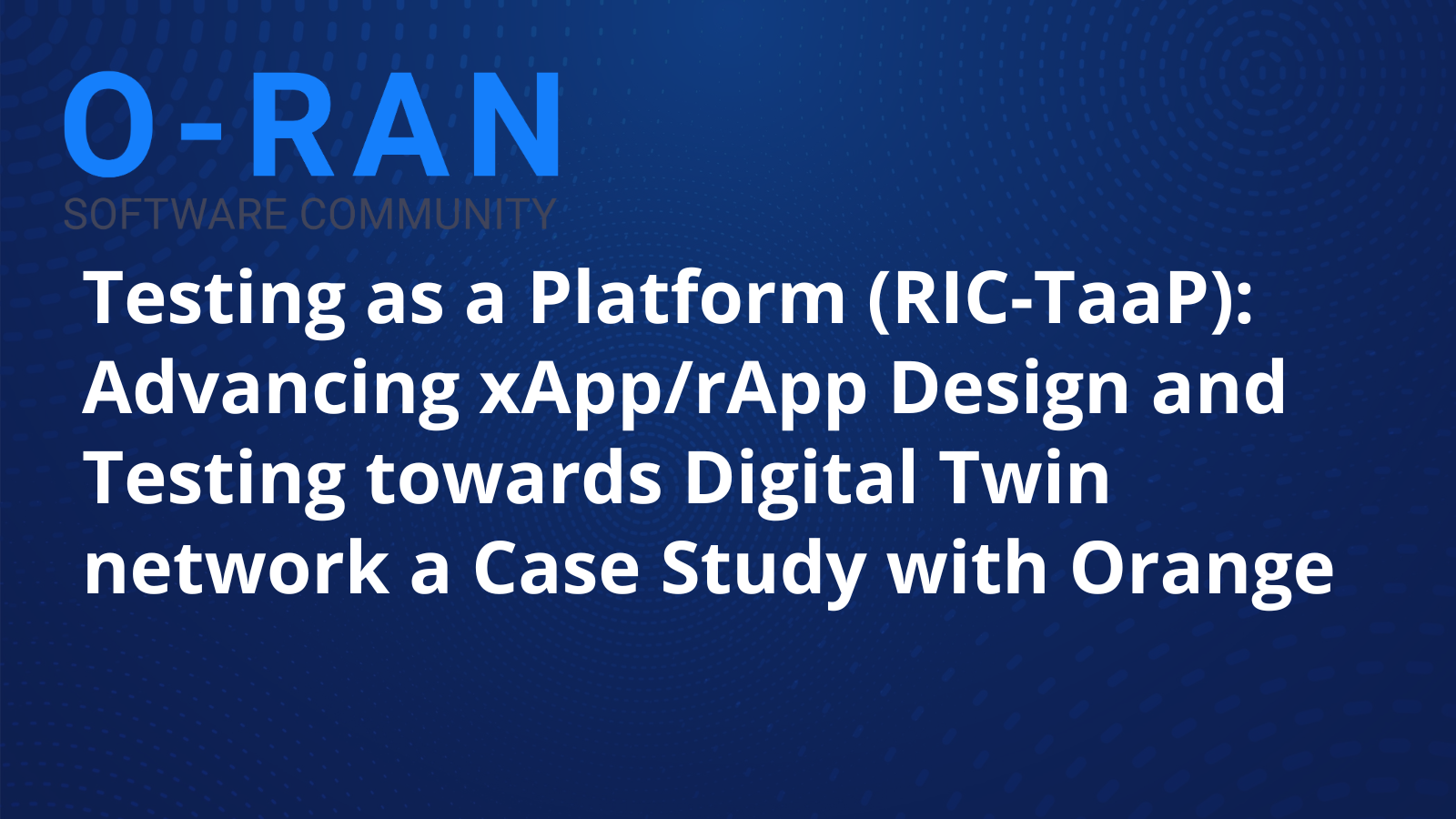
Author: Mina Yonan, Orange Innovation Egypt, mina.awadallah@orange.com
The adoption of the RAN Intelligent Controller (RIC) in networks encounters several challenges that may impede its objective and efficiency. To enable efficient and plug-and-play use cases, we can categorize these challenges into two key areas:
To address the aforementioned challenges, Orange has announced the development of RIC Testing as a Platform (RIC-TaaP)—an open source initiative designed to streamline xApp/rApp functional and operational testing, fostering innovation in xApp/rApp design and provide a proven digital-twin networks.
Recognizing the need for a robust, fully open source testing environment, Orange Innovation Egypt (OIE) has focused on enabling system-level use cases by leveraging advanced open source components. To achieve this, OIE has integrated FlexRIC from EURECOM with the ns-O-RAN simulator, originally developed by the Institute for the Wireless Internet of Things (WIoT) ,University of Padova and Mavenir. The team has enhanced the simulator to ensure full compliance with E2AP v1.01, KPM v3, and RC v1.03 standards, providing a sophisticated 5G simulation environment for validating complex use cases.
Additionally, Orange Innovation Poland (OIP) has augmented the platform with a user-friendly dashboard, RIC-TaaP Studio, enabling intuitive test scenario design and incorporating a range of operational features. Across its innovation centers, Orange continues to integrate leading open source solutions, including the 5G-LENA module, developed by the OpenSim Research Unit at the Centre Tecnològic de Telecomunicacions de Catalunya (CTTC).
Committed to openness and accessibility, Orange ensures that RIC-TaaP remains an open source and user-friendly platform, making Open RAN research and development more accessible to a broader community of engineers and researchers.
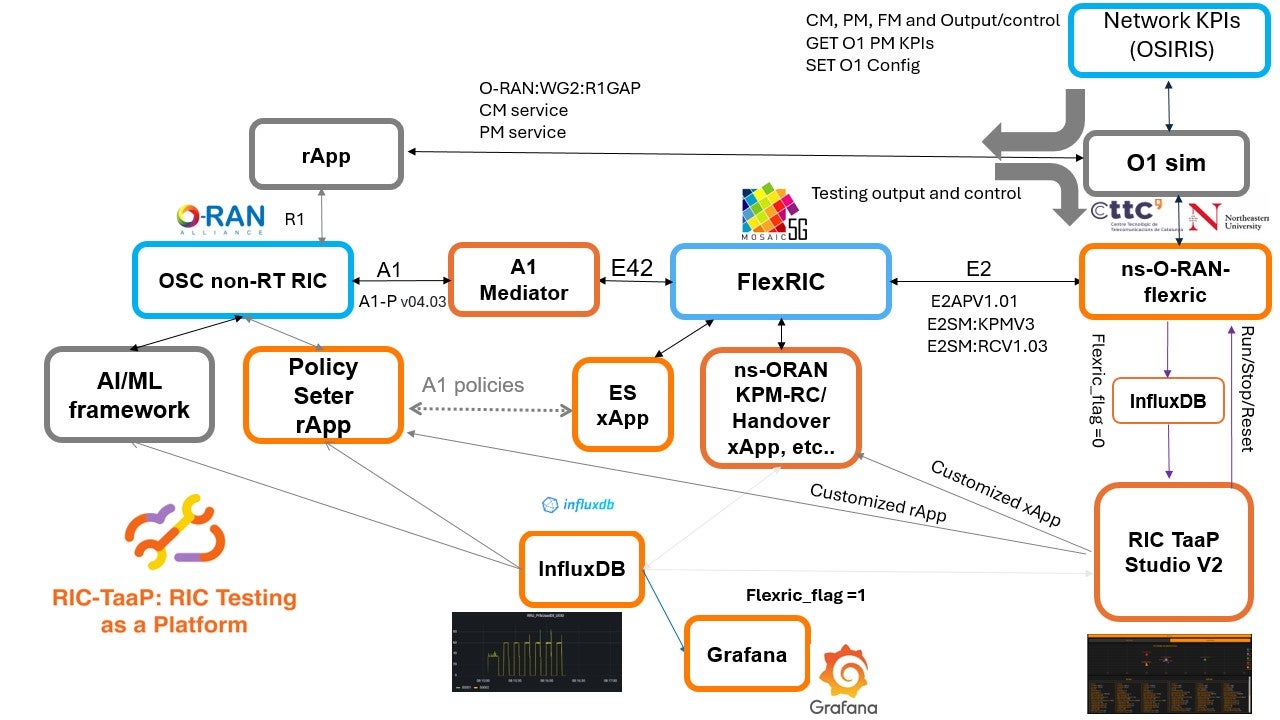
To establish a fully capable platform for xApp/rApp design and testing, RIC-TaaP comprises nine key components. These elements collectively form a flexible and robust network simulation environment, enabling efficient xApp/rApp development, validation, and deployment.
| E2APv1.01 | E2 SETUP REQUEST |
| E2 SETUP RESPONSE | |
| RIC SUBSCRIPTION REQUEST | |
| RIC SUBSCRIPTION RESPONSE | |
| RIC SUBSCRIPTION FAILURE | |
| RIC INDICATION | |
| RIC CONTROL REQUEST | |
| RIC CONTROL ACKNOWLEDGE | |
| RIC SUBSCRIPTION DELETE FAILURE | |
| RIC SUBSCRIPTION DELETE REQUEST | |
| RIC SUBSCRIPTION DELETE RESPONSE | |
| KPMv3 | List of KPIs supported by ns-O-RAN |
| RCv1.03 | – CONTROL Service Style 3 (Section 7.6) – Connected Mode Mobility Management (Section 7.6.4) – Control Action ID 1 (Handover Control) (Section 8.4.4.1) – Control Action ID 2 (Conditional Handover Control) (Section 8.4.4.2) – Control Action ID 3 (DAPS Handover Control) (Section 8.4.4.3) |

Use-case 21: Energy Saving under Cell Utilization “Cell on/off” as an example
The Energy Saving (ES) logic example in RIC-TaaP is driven by cell utilization, particularly Physical Resource Block (PRB) usage (%). The decision-making process follows a structured sequence, as illustrated in the diagram below:
The Energy Dashboard in RIC-TaaP Studio provides real-time monitoring of network performance and energy efficiency metrics. It includes three key categories:
Domain Leader: Eric Hardouin, Orange Innovation, eric.hardouin@orange.com
Program Leader: Fabrice Guillemin, Orange Innovation, fabrice.guillemin@orange.com
Project Leader: Alassane Samba,Orange Innovation, alassane.samba@orange.com